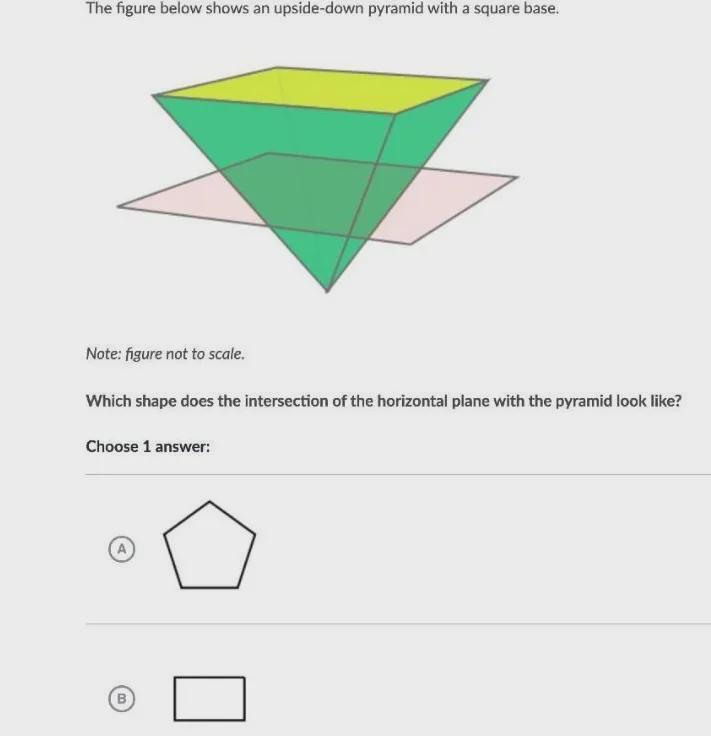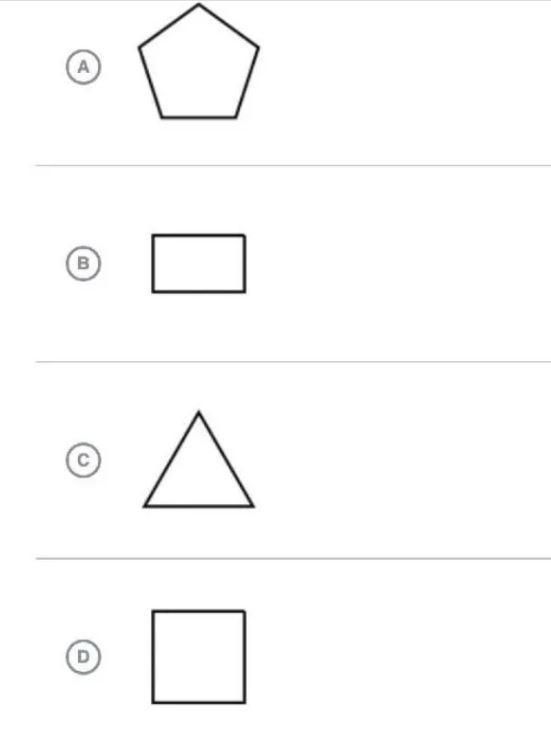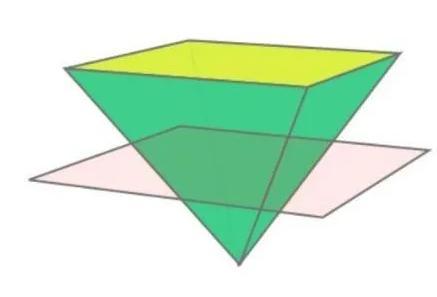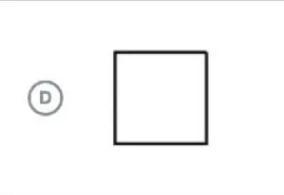The figure below shows an upside-down pyramid with a square base.inverted pyramid with a square baseNote: figure not to scale.Which shape does the intersection of the horizontal plane with the pyramid look like?


Answers
ANSWER:
EXPLANATION:
Given:
Since the pyramid has a square base, therefore intersection of the horizontal plane will produce a shape that looks like a square.


Related Questions
An isosceles triangle has an angle that measures 128°. Which other angles could be in that Isosceles triangle? Choose all that apply.
Answers
Given:
Given angle is 128 degree.
In Isosceles triangle two angles are equal.
Let the angle be x.
Sum of the angles in a triangle is 180 degree.
[tex]\begin{gathered} 128+x+x=180 \\ 2x=180-128 \\ 2x=52 \\ x=26^{\circ} \end{gathered}[/tex]Other angles in an Isosceles triangle is 26 degree.
A ladder 7.90 m long leans against the side of a building. If the ladder is inclined at an angle of 74.5° to the horizontal, what is the horizontal distance from the bottom of the ladder to the building?____________ m
Answers
First, let's sketch the problem:
To find the horizontal distance d, we can use the cosine relation of the angle 74.5°.
The cosine is equal to the length of the adjacent leg to the angle over the length of the hypotenuse.
So we have:
[tex]\begin{gathered} \cos74.5°=\frac{d}{7.9}\\ \\ 0.2672=\frac{d}{7.9}\\ \\ d=0.2672\cdot7.9\\ \\ d=2.11\text{ m} \end{gathered}[/tex]What is the density, in grams/cubic inch, of a substance with a mass of 6 grams filling a rectangular box with dimensions 2 in x 6 in x 3 in?6 8 0.11 0.17
Answers
Consider tha the density is calculated by using the following formula:
[tex]D=\frac{M}{V}[/tex]D is the density, M is the mass and V the volume. In this case, you have;
M = 6 g
V = 2 in x 6 in x 3 in = 36 in^3
Replace the previous values of the parameters into the formula for D:
[tex]D=\frac{6g}{36in^3}\approx0.17\frac{g}{in^3}[/tex]Hence, the density of the given substance is approximately 0.17 g/in^3
Find the center that eliminates the linear terms in the translation of 4x^2 - y^2 + 24x + 4y + 28 = 0.(-3, 2)(-3,- 2)(4, 0)
Answers
Step 1
Given;
[tex]4x^2-y^2+24x+4y+28=0[/tex]Required; To find the center that eliminates the linear terms
Step 2
[tex]\begin{gathered} 4x^2-y^2+24x+4y=-28 \\ 4x^2+24x-y^2+4y=-28 \\ Complete\text{ the square }; \\ 4x^2+24x \\ \text{use the form ax}^2+bx\text{ +c} \\ \text{where} \\ a=4 \\ b=24 \\ c=0 \end{gathered}[/tex][tex]\begin{gathered} consider\text{ the vertex }form\text{ of a }parabola \\ a(x+d)^2+e \\ d=\frac{b}{2a} \\ d=\frac{24}{2\times4} \\ d=\frac{24}{8} \\ d=3 \end{gathered}[/tex][tex]\begin{gathered} Find\text{ the value of e using }e=c-\frac{b^2}{4a} \\ e=0-\frac{24^2}{4\times4} \\ e=0-\frac{576}{16}=-36 \end{gathered}[/tex]Step 3
Substitute a,d,e into the vertex form
[tex]\begin{gathered} a(x+d)^2+e \\ 4(x+_{}3)^2-36 \end{gathered}[/tex][tex]\begin{gathered} 4(x+3)^2-36-y^2+4y=-28 \\ 4(x+3)^2-y^2+4y=\text{ -28+36} \\ \\ \end{gathered}[/tex]Step 4
Completing the square for -y²+4y
[tex]\begin{gathered} \text{use the form ax}^2+bx\text{ +c} \\ \text{where} \\ a=-1 \\ b=4 \\ c=0 \end{gathered}[/tex][tex]\begin{gathered} consider\text{ the vertex }form\text{ of a }parabola \\ a(x+d)^2+e \\ d=\frac{b}{2a} \\ d=\text{ }\frac{4}{2\times-1} \\ d=\frac{4}{-2} \\ d=-2 \end{gathered}[/tex][tex]\begin{gathered} Find\text{ the value of e using }e=c-\frac{b^2}{4a} \\ e=0-\frac{4^2}{4\times(-1)} \\ \\ e=0-\frac{16}{-4} \\ e=4 \end{gathered}[/tex]Step 5
Substitute a,d,e into the vertex form
[tex]\begin{gathered} a(y+d)^2+e \\ =-1(y+(-2))^2+4 \\ =-(y-2)^2+4 \end{gathered}[/tex]Step 6
[tex]\begin{gathered} 4(x+3)^2-y^2+4y=\text{ -28+36} \\ 4(x+3)^2-(y-2)^2+4=-28+36 \\ 4(x+3)^2-(y-2)^2=-28+36-4 \\ 4(x+3)^2-(y-2)^2=4 \\ \frac{4(x+3)^2}{4}-\frac{(y-2)^2}{4}=\frac{4}{4} \\ (x+3)^2-\frac{(y-2)^2}{2^2}=1 \end{gathered}[/tex]Step 7
[tex]\begin{gathered} \frac{(x-h)^2}{a^2}-\frac{(y-k)^2}{b^2}=1 \\ \text{This is the }form\text{ of a hyperbola.} \\ \text{From here } \\ a=1 \\ b=2 \\ k=2 \\ h=-3 \end{gathered}[/tex]Hence the answer is (-3,2)
The question is on the image below
Answers
Maximum number of identical boxes with no. of supply items in each box will be:
a. 78 boxes with 1 pencil and 1 eraser in each box.
b. 195 boxes with 1 notebook and 1 folder in each box.
c. 65 boxes with 1 eraser, 1 marker and 2 folders in each box.
First Lana will make 78 boxes with 1 pencil and 1 eraser in each box. After that she'll be left with
143 - 78 = 65 erasers.
Secondly she will make 195 boxes with 1 notebook and 1 folder in each box. After that she'll be left with
330 - 195 = 135 folders.
Next she will make 65 boxes with 1 eraser, 1 maker and 2 folders in each box.
By doing this she will be able to make maximum number of identical boxes.
To know more about identical boxes
https://brainly.com/question/14964607
#SPJ1
Hello, I need helping solving for x by completing the square.
Answers
EXPLANATION:
Given;
We are given the quadratic equation as shown below;
[tex]x^2-8x+13=0[/tex]Required;
We are required to solve for x by completing the square method.
Step-by-step solution;
We start with the constant 13.
Subtract 13 from both sides of the equation;
[tex]x^2-8x+13-13=0-13[/tex][tex]x^2-8x=-13[/tex]Next we take the coefficient of x (that is -8). We half it, and then square the result. After that we add it to both sides of the equation;
[tex]\begin{gathered} \frac{1}{2}\times-8=-\frac{8}{2} \\ Next: \\ (-\frac{8}{2})^2 \end{gathered}[/tex]We now have;
[tex]x^2-8x+(-\frac{8}{2})^2=-13+(-\frac{8}{2})^2[/tex]We can now simplify this;
[tex]x^2-8x+(-4)^2=-13+(-4)^2[/tex][tex]x^2-8x+16=-13+16[/tex][tex]x^2-8x+16=3[/tex]We now factorize the left side of the equation;
[tex]\begin{gathered} x^2-4x-4x+16 \\ (x^2-4x)-(4x-16) \\ x(x-4)-4(x-4) \\ (x-4)(x-4) \\ Therefore: \\ (x-4)^2 \end{gathered}[/tex]we can now refine our equation to become;
[tex](x-4)^2=3[/tex]We can now solve for x as follows;
Take the square root of both sides;
[tex]x-4=\pm\sqrt{3}[/tex]Therefore;
[tex]\begin{gathered} x-4=\sqrt{3} \\ x=\sqrt{3}+4 \\ Also: \\ x-4=-\sqrt{3} \\ x=-\sqrt{3}+4 \end{gathered}[/tex]ANSWER:
[tex]\begin{gathered} x_1=4+\sqrt{3} \\ x_2=4-\sqrt{3} \end{gathered}[/tex]Find anexpression which represents the sum of (-6x + 6) and (-3x – 7) insimplest terms.
Answers
We are asked to find the sum of the following expressions
[tex](-6x+6)\: \: and\: \: (-3x-7)[/tex]First of all, expand the parenthesis
[tex]\begin{gathered} (-6x+6)+\: (-3x-7) \\ -6x+6-3x-7 \end{gathered}[/tex]Now, collect the like terms together and add/subtract
[tex]\begin{gathered} -6x+6-3x-7 \\ (-6x-3x)+(6-7) \\ (-9x)+(-1)_{} \\ -9x-1 \end{gathered}[/tex]Therefore, the sum of the given expressions in the simplest form is
[tex]-9x-1[/tex]identify the same-side interior angles. Choose all the Apply<3 & <4<3 & <5<3 & <6<3 & <8
Answers
The same-side interior angles are also called consecutive interior angles. They are non-adjacent interior angles that lie on the same side of the transversal (in this case, t). Then, we have that these angles are:
[tex]\measuredangle3,\text{ }\measuredangle5[/tex]And
[tex]\measuredangle4,\measuredangle6[/tex]A graph to represent them:
From the options, we have that option B is one answer: <3 and <5. The other possible answer is <4 and <6 (not shown in the possible options).
I have taken a picture of the question. Thank you.
Answers
The original width of the rectangular piece of metal is 21 inches.
let us take into consideration the width of the rectangle be x,
Length is given to be 5 inches more than the width
∴ length = x+5
Now squares of side 1 inch is cut from all the corners of the rectangle to form a box in the form of a cuboid.
New length of the base of the box = (x+5) - 2 = x+3 inches
new width of the box = x -2 inches
Height of the box = 1 inch
Volume of the box that is formed
= (x+3 ) · (x -2) × 1
= x² - x - 6
The given volume of the box is 414 cubic inches
Therefore:
x² - x - 6 = 414
or, x² - x -420 = 0
Solving the quadratic equation by middle term factorization we get :
or, ( x - 21 ) ( x + 20 ) = 0
Now either x=-20( not possible)
or , x =21 inches.
Therefore the original width of the rectangle is 21 inches.
To learn more about rectangle visit:
https://brainly.com/question/14383947
#SPJ9
help me to complete this please help me help help help help help help help help
Answers
Hello
To solve this question, we just have to find 40% of 90
[tex]\begin{gathered} \frac{40}{100}=\frac{x}{90} \\ 0.4=\frac{x}{90} \\ x=90\times0.4 \\ x=36 \end{gathered}[/tex]From the calculations above, the castle has 36 girls present
Hello, I need help on the following question (it’s one problem but with multiple parts):
Answers
Part i. We are told that the cost for 3 throws is 1 dollar. This means that if "x" is the number of throws then the total cost must be:
[tex]C(x)=\frac{1\text{ dollar}}{3\text{ throws}}x[/tex]We can rewrite it in a simpler form as:
[tex]C(x)=\frac{1}{3}x[/tex]If we purchased the armband then this cost is equivalent to (1/6) of a dollar per throw plus the cost of the armband, we get:
[tex]C_2(x)=\frac{1}{6}x+10[/tex]Part ii. The graph of the two equations are two lines in the plane, like this:
In the graph, the red line represents the cost without the armband and the blue line represents the cost with the armband.
Part iii. We can see from the graph that if the number of throws is smaller than 60, then the cost is smaller without the armband, but if the cost is greater than 60 then the cost is smaller with the armband. Therefore, it makes sense to buy the armband if the number of throws is going to be greater than 60.
In 9-16, estimate each product. 9. 0.12 x 105 10. 45.3 x 4 11. 99.2 x 82 12. 37 x 0.93 13. 1.67 X4 14. 3.2 x 184 15. 12 x 0.37 16. 0.904 x 75
Answers
9.
[tex]\begin{gathered} 0.12\cdot105=12.6 \\ 10.\text{ 45.3}\cdot4=181.2 \\ 11.\text{ 99.2}\cdot82=8134.4 \\ 12.\text{ 37}\cdot0.93=34.41 \\ 13.\text{ 1.67}\cdot4=6.68 \\ 14.\text{ 3.2}\cdot184=588.8 \\ 15.\text{ 12}\cdot0.37=4.44 \\ 16.\text{ 0.904}\cdot75=67.8 \end{gathered}[/tex]In the form (x+4)(x-2)=1, the zero-factor property can or cannot be used to solve equation?
Answers
The zero-factor property is
[tex](x+a)(x+b)=0[/tex]Then we equate each factor by 0 and find the values of x
The given equation is
[tex](x+4)(x-2)=1[/tex]Since the right side is not equal to 0, then
We can not use the zero-factor property to solve the equation
The answer is
zero-factor property cannot be used
36\100 as a percentage
Answers
Notice that in the fraction
[tex]\frac{36}{100}[/tex]Can be interpreted as "36 out of every 100"
As a percentage, this means 36%
In Seattle, the tax on a property assessed at $500,000 is $9,000. If tax rates are proportional in this city, how much would the tax be on a property assessed at $1,000,000?
Answers
Answer:
$18,000
Explanation:
Let us represent the tax by y and the property value by x. If the tax is proportional to the property value, then the relationship between y and x is the following.
[tex]y=kx[/tex]where k is the constant of propotionality.
Now, to paraphrase, we are told that when y = $9,000, then x = $500,000. This means
[tex]9000=k(500,000)[/tex]and we need to solve for k.
Dividing both sides by 9000 gives
[tex]k=\frac{9,000}{500,000}[/tex]which simplifies to give
[tex]\boxed{k=\frac{9}{500}.}[/tex]With the value of k in hand, our formula now becomes
[tex]y=\frac{9}{500}x[/tex]We can now find the tax when x = 1,000,000.
Putting in x = 1,000,000 into the above formula gives
[tex]y=\frac{9}{500}(1,000,000)[/tex]which simplifies to give
[tex]\boxed{y=18,000.}[/tex]This means, the tax on a property assessed at $1,000,000 is $18,000.
Find the difference. Express the answer in scientific notation.(4.56 times 10 Superscript negative 13 Baseline) minus (1.17 times 10 Superscript negative 13)3.39 times 10 Superscript negative 265.73 times 10 Superscript negative 263.39 times 10 Superscript negative 135.73 times 10 Superscript negative 13
Answers
Given:
given expression is
[tex](4.56\times10^{-13})-(1.17\times10^{-13})[/tex]Find:
we have to elavuate the difference and write the answer in scientific notation.
Explanation:
we will evaluate the expression as follows
[tex](4.56\times10^{-13})-(1.17\times10^{-13})=(4.56-1.17)\times10^{-13}=3.39\times10^{-13}[/tex]Therefore, correct option is
[tex]3.39\times10^{-13}[/tex]TIME SENSITIVE The first step in solving this equation is to (BLANK) the second step is to (BLANK) solving this equation for X initially yields (BLANK) checking solution shows that (BLANK= 0 and 2 are valid solutions)
Answers
Give
[tex](4x)^{\frac{1}{3}}-x=0[/tex]
Procedure
The first step in solving this equation is to add x to both sides
[tex](4x)^{\frac{1}{3}}=x[/tex]The second step is to cube both sides
[tex]4x=x^3[/tex]solving this equation for X initially yields in three solutions
[tex]\begin{gathered} x(4-x^2)=0 \\ x(2-x)(2+x)=0 \end{gathered}[/tex]checking solution shows that x = 0, x = -2 and x = 2
Choose and evaluate an exponential expression that models the situation.A 1-inch vine begins tripling its length every week. After the first week, the length of the vine is3 inches. After the second week, the length is 9 inches. If this growth pattern continues, howlong will the vine be in 6 weeks?See image below for answer options.
Answers
The pattern is:
3
3x3
3x3x3
and so on
So it's 3^6 = 729
Answer: the second option
make a triangular garden in the backyard. you know that one side of your yard (ac) is 100 yards long and another side (ab) is 250 yards. in order for the garden to fit and not cross into the neighbor's yard, what must be the measure of angle b if angel c measures 95 degrees?
Answers
Law of sines for the given triangle:
[tex]\frac{AC}{\sin B}=\frac{AB}{\sin C}[/tex]Use the equation above and the given data to solve angle B:
[tex]undefined[/tex]I have to write the equation in slope intercept form. i need help, please. thank you
Answers
step 1
find the slope
we have the points
(-6,10) and (-3,-2)
m=(-2-10)/(-3+6)
m=-12/3
m=-4
step 2
find the equation in point slope form
y-y1=m(x-x1)
we have
m=-4
(x1,y1)=(-6,10)
substitute
y-10=-4(x+6)
step 3
convert to slope intercept form
isolate the variable y
y-10=-4x-24
y=-4x-24+10
y=-4x-14
Solve the system of equations.−2x+5y =−217x+2y =15
Answers
To solve this question we will use the elimination method.
Adding 7 times the first equation to 2 times the second equation we get:
[tex]14x+4y+(-14x)+35y=30+(-147)\text{.}[/tex]Simplifying the above equation we get:
[tex]4y+35y=-117.[/tex]Solving for y we get:
[tex]\begin{gathered} 39y=-117, \\ y=-\frac{117}{39}, \\ y=-3. \end{gathered}[/tex]Substituting y=-3 in the first equation, and solving for x we get:
[tex]\begin{gathered} -2x+5(-3)=-21, \\ -2x-15=-21, \\ -2x=-6, \\ x=3. \end{gathered}[/tex]Answer:
[tex]\begin{gathered} x=3, \\ y=-3. \end{gathered}[/tex]A game center has a $5 admission fee and charges $0.50 for each game played. Graph the equation on the coordinate plane. Be sure to label the axes appropriately and provide a scale for the axes.
Answers
A game center has a $5 admission fee (this is the y-intercept of the equation)
It charges $0.50 for each game played (this is the slope of the equation)
The equation can be written as
[tex]y=0.50x+5[/tex]Where y is the cost and x is the number of games played.
To plot the graph, you can either find some (x, y) coordinates using the above equation.
Or you can plot it using the concept of slope and y-intercept.
Start at the point of y-intercept (0, 5)
The slope is 0.50 = 1/2
Then go 1 unit up and two units to the right that is your next point.
Repeat the same, 1 unit up and two units to the right that is your next point and so on...
Let us plot the graph
Scale: one small box = 1 unit
x-axis = number of games
y-axis = Cost ($)
A rectangular shaped garden is 2 feet longer than the width fios aree is 13sq feet find the dimensions
Answers
We are given that the length a rectangular-shaped figure is 2 feet longer than its width. This can be written mathematically as:
[tex]l=w+2[/tex]Where "l" is the length and "w" is the width. WE are also told that the area is 13 square feet. Since the area is the product of the length and the width this means the following:
[tex]lw=13[/tex]From the previous equation we solve for the length by dividing both sides by its width:
[tex]l=\frac{13}{w}[/tex]Now we replace this in the first equation:
[tex]\frac{13}{w}=w+2[/tex]Now we multiply both sides by the width:
[tex]13=w^2+2w[/tex]Subtracting 13 to both sides:
[tex]w^2+2w-13=0[/tex]We get a quadratic equation. To solve this equation we will factor the equation by completing the square:
[tex](w^2+2w+1)-14=0[/tex]Factoring the parenthesis:
[tex](w+1)^2-14=0[/tex]Now we add 14 to both sides:
[tex](w+1)^2=14[/tex]Taking square root to both sides:
[tex]w+1=\pm\sqrt[]{14}[/tex]Subtracting 1 to both sides:
[tex]w=-1\pm\sqrt[]{14}[/tex]We take the positive value for the width, that is:
[tex]\begin{gathered} w=-1+\sqrt[]{14} \\ w=2.74ft \end{gathered}[/tex]Now we replace this value of the width in the first equation:
[tex]\begin{gathered} l=2.74ft+2ft \\ l=4.74ft \end{gathered}[/tex]Therefore, the dimensions are:
[tex]\begin{gathered} w=2.74ft \\ l=4.74ft \end{gathered}[/tex]ABCD is a parallelogram Find m angle C.В,11492x + 1234A4
Answers
Given the parallelogram ABCD:
The sum of every two adjacent angles = 180
so,
m∠B + m∠C = 180
m∠C = 180 - m∠B = 180 - 114 = 66
So, the answer will be m∠C = 66
what is the distance between A and B B(4,5) A(-3,-4)
Answers
11.40 units
Explanation
Step 1
you can easily find the distance between 2 points using:
[tex]\begin{gathered} d=\sqrt[]{(y_2-y_1)^2+(x_2-x_1)^2} \\ \text{where} \\ P1(x_1,y_1)\text{ and } \\ P2(x_2,y_2) \end{gathered}[/tex]Step 2
Let
A=P1(-3,-4)
B=P2(4,5)
Step 3
replace
[tex]\begin{gathered} d=\sqrt[]{(y_2-y_1)^2+(x_2-x_1)^2} \\ d=\sqrt[]{(5-(-4))^2+(4-(-3))^2} \\ d=\sqrt[]{(9)^2+(7)^2} \\ d=\sqrt[]{81+49} \\ d=\sqrt[]{130} \\ d=\text{11}.40 \end{gathered}[/tex]I hope this helps you
Given P = 2L + 2W. Solve for W if P = 52 and L 18 W
Answers
First begin by making w the subject of formula
p = 2l + 2w
p-2l = 2w ( moving 2l to the left hand side )
[tex]\begin{gathered} \\ \frac{p\text{ - 2l}}{2}\text{ = w ( now we've made w the subject )} \end{gathered}[/tex]next substitute in your values p = 52 and l = 18
[tex]w\text{ = }\frac{p\text{ - 2l}}{2}\text{ = }\frac{52\text{ - 2(18)}}{2}\text{ = }\frac{52\text{ - 36}}{2}\text{ = }\frac{16}{2}\text{ = 8}[/tex]
Therefore the value for w in the expression is 8
A veterinarian is enclosing a rectangular outdoor running area against his building for the dogs he cares for (see image). He wants to maximize the area using 108 feet of fencing.
Answers
ANSWER
The width that will give the maximum area is 27 feet. The maximum area is 1458 square feet.
EXPLANATION
The equation that gives the area is a quadratic function,
[tex]A(x)=x(108-2x)[/tex]To find the width that maximizes the area, we have to find the x-coordinate of the vertex of this parabola. We can observe in the equation that the leading coefficient is -2, so the vertex is the maximum.
First, apply the distributive property to write the equation in standard form,
[tex]A(x)=-2x^2+108x[/tex]The x-coordinate of the vertex of a parabola if the equation is in standard form is,
[tex]\begin{gathered} y=ax^2+bx+c \\ \\ x_{vertex}=\frac{-b}{2a} \end{gathered}[/tex]In this case, b = 108 and a = -2,
[tex]x_{vertex}=\frac{-108}{-2\cdot2}=\frac{108}{4}=27[/tex]Hence, the width that will give the maximum area is 27 feet.
To find the maximum area, we have to find A(27),
[tex]A(27)=27(108-2\cdot27)=27(108-54)=27\cdot54=1458[/tex]Hence, the maximum area is 1458 square feet.
Problem ID: PRABDN8J Use what you know about exponential notation to complete the expressions below. (-5) X -X(-5) = 17 times Use the ^ symbol to represent an exponent. For example: (-5)2 should be typed as (-5)^2 engage Type your answer below (numeric expression Submit Answer
Answers
Since (-5)2 using the exponential symbol can be written as (-5)^2
This means -5 in 2 places
(-5)X, using the exponential symbol, can be written as (-5)^X
X(-5), using the exponential symbol can be written as X^(-5)
Therefore:
(-5)X - X(-5) = 17, in exponential form, can be written as:
(-5)^X - X^(-5) = 17
[tex](-5)^X-X^{-5}=\text{ 17}[/tex]Can you help me with number 14? Thank you I am having trouble with it.
Answers
To solve number 14, we will make use of the Law of Cosines, which states that:
[tex]=\sqrt[]{^2+^2^{}-2\cos}[/tex]As in our problem b = 15, c = 13 and A = 95°,we can replace these values in the formula and solve for a:
[tex]=\sqrt[]{15^2+13^2-2\cdot(15\cdot13)\cos 95}[/tex][tex]=\sqrt[]{15^2+13^2-390\cos 95}[/tex][tex]a\approx20.69[/tex]In our case, a is the segment BC.
Answer: 20.7
Sara made an error in solve the one-step equation below.5x + 9 = 29-9 -9- 4x = 29/4. /4x = -7.25What is the error that Sara made?What should Sara had done to solve the one-step equation above insteadof what she did?What is the answer that Sara should have found for the above one-step equation?*
Answers
To solve this one-step equation you:
1. Substract 9 in both sides of the equation:
In this step is the mistake as Sara gets as result -4x=29 and the corret result of substract 9 in both sides of the equation is 5x=20.2. Divide both sides of the equation into 5:
Then, the answer that Sara should found for the equation is x=4